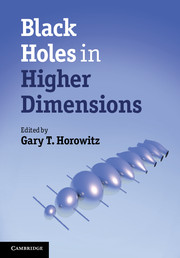Book contents
- Frontmatter
- Contents
- List of contributors
- Preface
- Part I Introduction
- Part II Kaluza–Klein thoery
- Part III Asymptotically flat solutions
- Part IV General properties
- 7 Constraints on the topology of higher-dimensional black holes
- 8 Blackfolds
- 9 Algebraically special solutions in higher dimensions
- 10 Numerical construction of static and stationary black holes
- Part V Advanced topics
- Index
8 - Blackfolds
from Part IV - General properties
Published online by Cambridge University Press: 05 May 2012
- Frontmatter
- Contents
- List of contributors
- Preface
- Part I Introduction
- Part II Kaluza–Klein thoery
- Part III Asymptotically flat solutions
- Part IV General properties
- 7 Constraints on the topology of higher-dimensional black holes
- 8 Blackfolds
- 9 Algebraically special solutions in higher dimensions
- 10 Numerical construction of static and stationary black holes
- Part V Advanced topics
- Index
Summary
Introduction
The existence of black p-branes in higher-dimensional general relativity hints at the possibility of large classes of black holes without any four-dimensional counterpart. Black rings provide a nice explicit example; in Chapter 6 they were introduced as the result of the bending of a black string into the shape of a circle and spinning it up to balance forces. One can naturally expect that this heuristic construction extends to other black branes. If the worldvolume of a black p-brane could be similarly bent into the shape of a compact hypersurface, for instance that of a torus Tp or a sphere Sp, we would obtain many new geometries and topologies of black hole horizons.
Unfortunately, the techniques that allow one to construct exact black hole solutions in four and five dimensions have not been successfully extended to more dimensions. Still, one may want to hold on to the intuition that a long circular black string, or more generally a smoothly bent black brane, could be obtained as a perturbation of a straight one.
The experience with brane-like objects in other areas of physics suggests that such approximate methods may be efficiently applied to this problem. Consider, for instance, the Abelian Higgs theory and its familiar string-like vortex solutions. These are first obtained in the form of static straight strings, but one would expect that they can also bend and vibrate.
- Type
- Chapter
- Information
- Black Holes in Higher Dimensions , pp. 180 - 212Publisher: Cambridge University PressPrint publication year: 2012
- 3
- Cited by

